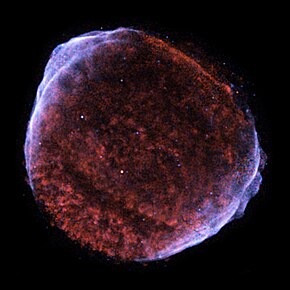
Back SN 1006 Afrikaans مستعر أعظم 1006 Arabic SN 1006 Catalan Supernova 1006 Czech Supernova 1006 German SN 1006 Spanish اسان ۱۰۰۶ Persian SN 1006 Finnish SN 1006 French סופרנובה 1006 HE
 False-colour X-ray image of SN 1006 supernova remnant | |
| Event type | Supernova, supernova remnant, astronomical radio source, astrophysical X-ray source |
|---|---|
| Type Ia (presumably) | |
| Date | April 17, 1006 to May 1, 1006 |
| Constellation | Lupus |
| Right ascension | 15h 2m 8s |
| Declination | −41° 57′ |
| Epoch | J2000 |
| Galactic coordinates | 327.6+14.6 |
| Distance | 7,200 light-years (2.2 kpc) |
| Remnant | Shell |
| Host | Milky Way |
| Progenitor | Unknown |
| Progenitor type | Unknown |
| Colour (B-V) | Japanese observers describe as blue-white at visible spectrum[1] |
| Notable features | Brightest supernova in recorded history, and therefore most described of the pretelescopic era |
| Peak apparent magnitude | −7.5[2] |
| Other designations | SN 1006, SN 1006A, SN 1016, SNR G327.6+14.6, SNR G327.6+14.5, 1ES 1500-41.5, MRC 1459-417, XSS J15031-4149, PKS 1459-41, AJG 37, 4U 1458-41, 3U 1439-39, 2U 1440-39, MSH 14-4-15, PKS 1459-419, PKS J1502-4205 |
| Preceded by | SN 393 |
| Followed by | SN 1054 |
| | |
Preview warning: Page using Template:Infobox astronomical event with unknown parameter "image_size"
SN 1006 was a supernova that is likely the brightest observed stellar event in recorded history, reaching an estimated −7.5 visual magnitude,[3] and exceeding roughly sixteen times the brightness of Venus. Appearing between April 30 and May 1, 1006, in the constellation of Lupus, this "guest star" was described by observers across China, Japan, modern-day Iraq, Egypt, and Europe,[1][4] and was possibly recorded in North American petroglyphs.[5] Some reports state it was clearly visible in the daytime. Modern astronomers now consider its distance from Earth to be about 7,200 light-years or 2,200 parsecs.[2]
- ^ a b Cite error: The named reference
Murdinwas invoked but never defined (see the help page). - ^ a b Winkler, P. F.; Gupta, Gaurav; Long, Knox S. (2003). "The SN 1006 Remnant: Optical Proper Motions, Deep Imaging, Distance, and Brightness at Maximum". The Astrophysical Journal. 585 (1): 324–335. arXiv:astro-ph/0208415. Bibcode:2003ApJ...585..324W. doi:10.1086/345985. S2CID 1626564. |bibcode=2003ApJ...585..324W
- ^ "Astronomers Peg Brightness of History's Brightest Star" (Press release). National Optical Astronomy Observatory. March 5, 2003. Archived from the original on April 2, 2003. Retrieved January 12, 2009.
- ^ Burnham, Robert Jr. The Celestial handbook. Dover, 1978. pp. 1117–1122.
- ^ Than, Ker (June 5, 2006). "Ancient Rock Art Depicts Exploding Star". Space.com.
© MMXXIII Rich X Search. We shall prevail. All rights reserved. Rich X Search